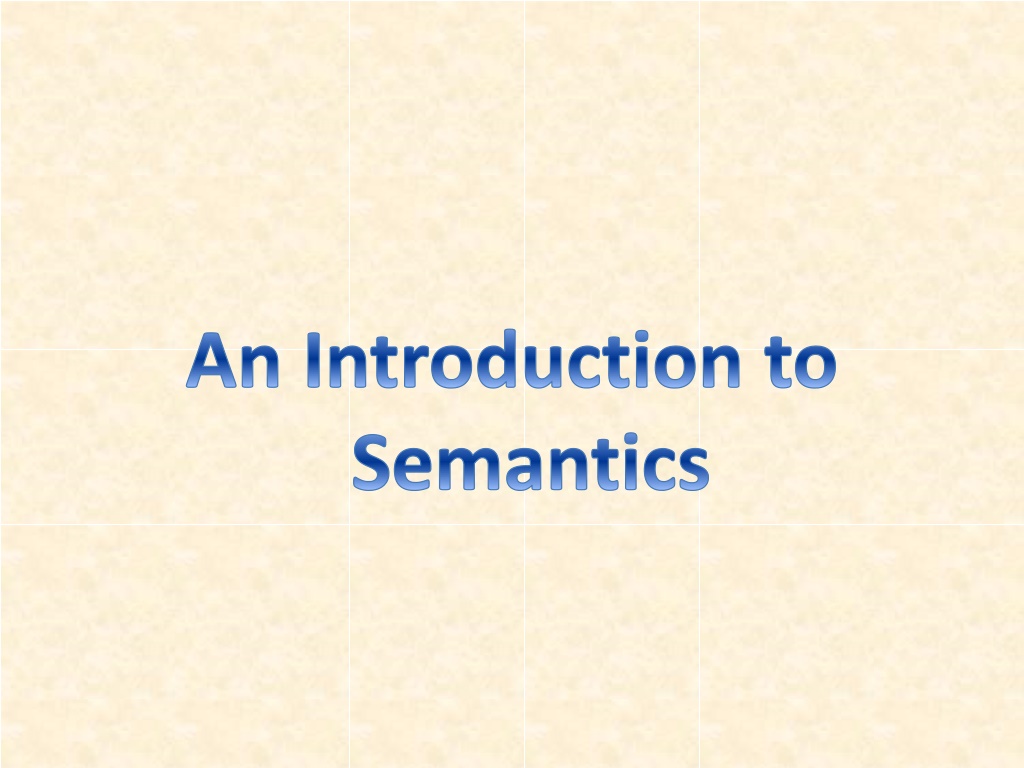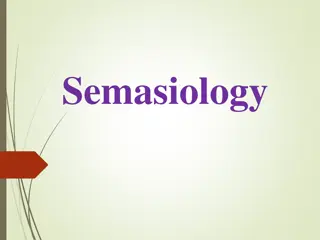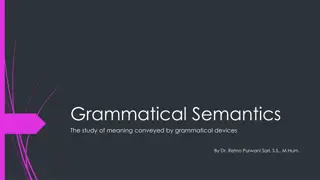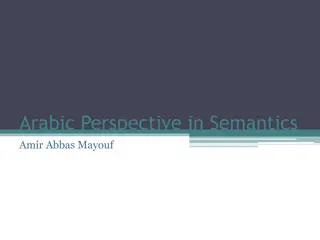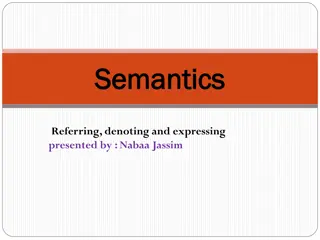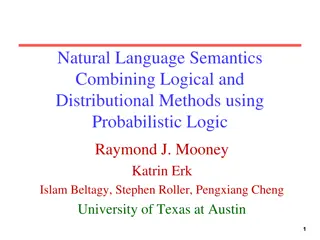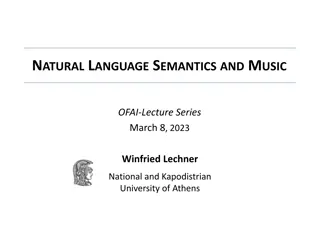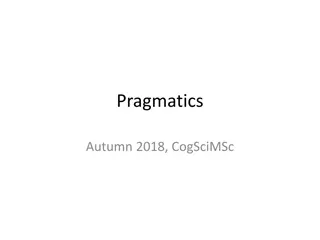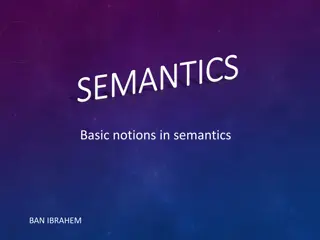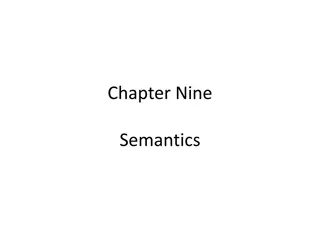Understanding Semantics: The Study of Meaning in Language
Semantics is the branch of linguistics focusing on meaning, exploring how words, sentences, and symbols convey and represent ideas. It is crucial for language acquisition, change, social contexts, and linguistic analysis. Important aspects include symbol and referent relationships, denotation, connotation, pragmatics, ambiguity, metaphor, and semantic fields.
Download Presentation

Please find below an Image/Link to download the presentation.
The content on the website is provided AS IS for your information and personal use only. It may not be sold, licensed, or shared on other websites without obtaining consent from the author. Download presentation by click this link. If you encounter any issues during the download, it is possible that the publisher has removed the file from their server.
E N D
Presentation Transcript
An Introduction to Semantics
Semantics Semantics is the branch of linguistics that deals with the study of meaning, changes in meaning, principles that govern the relationship between sentences or words and their meanings. It is the study of the relationships between signs and symbols and what they represent. and the
What is semantics? Semantics is the study of meaning in language. It is a wide subject within the general study of language. An understanding essential to the acquisition (how language users acquire a sense of meaning, writers, listeners and readers). It is also essential to the study of language change (how meanings alter over time) of semantics of is study language as speakers and
It is important for understanding language in social contexts, as these are likely to affect meaning, and for understanding varieties of English and effects of style. It is thus one of the most fundamental concepts in linguistics. The study of semantics includes the study of how meaning interpreted, clarified, obscured, illustrated, simplified, negotiated, contradicted, and paraphrased. is constructed,
Some important areas of semantic theory or related subjects include these: Symbol and referent Conceptions of meaning Words and lexemes Denotation, connotation, implication Pragmatics Ambiguity Metaphor, simile and symbol Semantic fields
Synonym, antonym and hyponym Collocation, fixed expression and idiom Semantic change and etymology Polysemy Homonymy, homographs Lexicology and lexicography Thesauruses, libraries and Web portals Epistemology Colour homophones and
The noun semantics and the adjective semantic are derived from the Greek word semantikos ( significant ). In linguistics, semantics subfield that is devoted to the study of meaning, as borne on the syntactic levels of words, phrases, sentences, and sometimes discourse, generically referred to as texts. is the larger units of
For thousands of years, philosophers have pondered the meaning, yet speakers of a language can understand what is said to them and can produce strings of words that are meaningful to other speakers. meaning of
To understand language we need to know the meaning of words and the morphemes them. We also must know how the meanings of words combine into phrases and sentence meanings. Finally, we must consider context when determining meaning. The study of meaning of morphemes, words, that compose the linguistic
Subfields of semantics are lexical (of or relating to the vocabulary, words, or morphemes of a language) semantics, which is concerned with the meanings of words, and relationships among words; and phrasal or sentential semantics, concerned with syntactic units larger than the word. the meaning which is of the meaning
The study of how context affects meaning is called Pragmatics. For example, the sentence "It's cold in here" can be interpreted in certain situations as "close the windows".
Colorless green ideas sleep furiously The sentence "Colorless green ideas sleep furiously" was Chomsky as a great example of a series of words strung together randomly. It grammatical according to the lexical classification, however, it is non-sense on a semantic level. Or so goes the claim. But is the claim correct? presented by
According to a well-established usage of the word "green", a green idea is one that is new and untried. Again, a colorless idea is one without vividness, dull, and unexciting. So it follows that a colorless green idea is a new, untried idea that is without vividness, dull, and unexciting.
To sleep is, among other things, to be in a state of dormancy or inactivity, or in a state of unconsciousness. To sleep furiously may seem a puzzling turn of phrase but one reflects that the mind in sleep often indeed moves furiously with ideas and images flickering in and out.
So, what is the poet telling us? (One assumes that the quoted line is from the work of a poet working in a medium of studied ambiguity. Or rather, as we shall see...) Very simply the poet seems to be saying that new ideas, not yet sharply defined, circulate in the unconscious, rapidly altering at a furious rate. precision and
One is left then with a question. Why is this nice bit of poetic imagery cited by its author as a quintessentially meaningless sentence? Here we have an exquisite bit of irony. The author evidently has a turn for poetry, a turn which he turns his face against. And the hidden face, the denied self, has taken its revenge. The scientist has called on his creative self to exhibit a bit of nonsense.
The poet denied has replied with a sentence, apparently meaningless, which is no such thing when listened to with an attentive ear. And yet consider; this sentence is a very production - it is indeed "colorless". It was, we suspect, a new idea, a variant of a possibility, still new at the very moment of production, one occurring by chance in the froth of the unconscious. intellectualized
In short, the cited sentence was a colorless green idea that had slept furiously.
